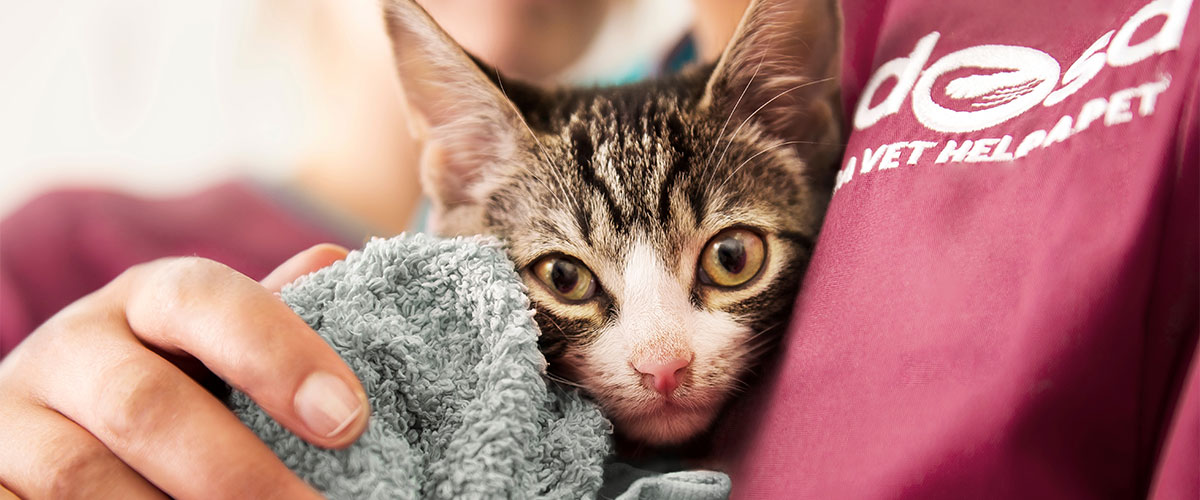Keeping your cat safe outdoors

Letting your cat outside for the first time can be exciting but also a bit nerve-wracking. However, the benefits often outweigh the risks, as cats thrive on outdoor stimulation. Before letting your cat outside, ensure they are:
- Microchipped: Will help identify them if they get lost or injured.
- Neutered: Prevents unwanted pregnancies, reduces territorial behaviour, reduces the risk of them catching an infectious disease through fighting or sexual contact with other cats, and makes them less likely to roam.
- Vaccinated: Protect your cat from preventable diseases.
- Treated for fleas and worms: Prevent infestations and associated health problems.
- Insured: This provides financial support in case of illness or accidents.
Kittens:
- Wait until your kitten is at least six months old before letting them outside. At this point, they’ll be almost fully grown, and will have developed some necessary survival skills.
- However, if you don’t think they are sensible enough to go out alone at six months, it might be best to wait a few more weeks.
Adult cats:
- Allow a settling in period - if you’ve recently got a new cat or have moved home, wait at least two weeks before allowing them outside, so they have time to settle in their new surroundings.
- However, some cats become very stressed if they are kept indoors, so if they are restless, pacing, or repeatedly scratching at doors, you may need to let them outside sooner. If this is the case, speak to your vet for further advice.
Step-by-step guide to letting your cat outside
Here are some tips to help make your cat's first trip outdoors as stress-free and safe as possible:
- Teach your cat to come when called: Before letting them outside, train them to respond to a specific sound or command. Reward them with a treat every time they come to you.
- Make your garden safe: Remove any potential harmful items such as sharp objects and toxic plants. Read more about garden poisons and hazards.
- Start with a short, supervised trip: Choose a fair-weather day and time the outing just before a meal time so they’re more likely to return for food.
- Lead the way outside: Let your cat follow you, keeping the door open at all times.
- Let them explore: Let them explore on their own but also call them back every few minutes for a treat.
- Gradual exposure: Repeat this daily, slowly increasing the time they are out each day.
- Allow free roaming: Once they are comfortable exploring on their own, you can them roam freely.
- Reward for returning home: Continue giving them a treat for coming back to encourage them to stay within a safe range.

Cats are territorial creatures and often end up fighting if their territories overlap. It’s important to try and prevent cat fights because they can lead to nasty injuries such as cat bite abscesses and stress related problems such as cystitis. Here are some top tips:
- Neuter your cat: Neutered cats are generally less territorial and less likely to fight.
- Use a microchip cat flap: This will prevent other cats from entering your home.
- Establish a routine: If possible, you could try to coordinate outdoor time with other cat owners in the neighbourhood so your cats don’t cross paths. However, this can be difficult to organise, and you’ll need to be flexible if either cat becomes stressed with their new routine. Alternatively, you could try keeping your cat indoors during the times you know other cats are around, but again be flexible if your cat becomes stressed.
- Consider cat-proofing your garden: As a last resort, a high fence with a 45-degree angle at the top will keep your cat in and other cats out. However, it’s important to remember that being confined to your home and garden could be very stressful for your cat, so you’ll need to make sure you spend lots of time playing with them, and give them plenty of things to do in the garden. For some cats, being confined to the house and garden isn’t possible due to the stress it causes.

Any cat that spends time outdoors is at risk of being in a road traffic accident so it’s important to take steps to keep your cat as safe as possible.
- Neutering: This will stop them roaming to find a mate, making them much less likely to get hit by a car.
- Microchipping: Microchips enable cats to be quickly reunited with their owners if they go missing or are involved in a road traffic accident. It’s now a legal requirement for all cats to be microchipped by 20 weeks of age.
- Consider keeping your cat indoors at night: Some studies show that cats are more likely to be involved in road traffic accidents at night.
- Reflective collars: if your cat roams freely at night, a quick-release reflective collar might help to keep them safe on the roads. However, collars don’t come without risks so make sure to read our cat collar advice.
Keeping your cat cool in warm weather
Cats are generally good at regulating their temperature, but on extremely hot days, you can take extra precautions to keep them cool.
- Sun protection: For cats with light-coloured fur, apply pet-safe sunscreen to areas with less fur coverage, like the ears, nose, and above the eyes. Excessive sun exposure can increase the risk of skin cancer.
- Shade: Provide plenty of shade in your garden or keep your cat indoors during the hottest parts of the day.
Keeping your cat safe and warm in cold weather
During cold months, ensure your cat has a warm place to shelter from the elements.
- Indoor access: Allow your cat to come inside whenever they want.
- Outdoor shelter: If your cat enjoys spending time outdoors, provide a warm, insulated shelter for them.
- Antifreeze: Keep antifreeze away from your cat as it's extremely toxic.
Published: September 2024

